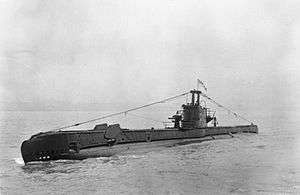HMS Sickle (P224)
 HMS Sickle | |
| History | |
|---|---|
| Class and type: | S class submarine |
| Name: | HMS Sickle |
| Builder: | Cammell Laird & Co Limited, Birkenhead |
| Laid down: | 8 May 1941 |
| Launched: | 27 August 1942 |
| Commissioned: | 1 December 1942 |
| Fate: | Was likely sunk June 1944 |
| General characteristics | |
| Displacement: |
|
| Length: | 217 ft (66 m) |
| Beam: | 23 ft 6 in (7.16 m) |
| Draught: | 11 ft (3.4 m) |
| Speed: |
|
| Complement: | 48 officers and men |
| Armament: |
|

HMS Sickle was an S class submarine of the Royal Navy, and part of the Third Group built of that class. She was built by Cammell Laird and launched on 27 August 1942. So far, she is the only ship to bear the name Sickle, after the farming implement.
Career
Sickle began her wartime career operating in the Mediterranean, where she sank the German submarine U-303, the German auxiliary submarine chaser UJ-2213/Heureux, the Italian auxiliary minesweepers No. 61/ Costante Neri, V 131/Amgiola Maria C. and No. 164/ Rosa Madre, and the German escort vessel SG-10/Felix Henri. The former fruit transport ship Felix Henri had been modified into an auxiliary cruiser by the French in 1940. She was captured by German troops on 14 December 1942 in Marseilles, modified into the fast escort vessel SG-10, commissioned on 1 May 1943 and attached to the 3rd escort flotilla. Sickle also sank ten sailing vessels and the German merchant Reaumur. Sickle also attacked and damaged the Italian merchants Oriani and Giovanni Boccaccio. The Giovanni Boccaccio was later beached to prevent her from sinking. The Italian merchant Mauro Croce, the German submarine U-755, the German auxiliary submarine chaser UJ 2210 and the German transport Lola were also attacked, but unsuccessfully.[1]
Sinking
Sickle left for a patrol in the northern Aegean on 31 May 1944. She was in action on 4 June when she fired upon shipping in Mitylene Harbour and later engaged in a gun battle with two German patrol vessels. During the battle, one member of the crew was washed overboard and taken prisoner. Sickle escaped the engagement and continued on her patrol. On 12 June she spotted a convoy in the approach to Steno Pass. The convoy suspected the presence of a submarine and dropped two depth charges. Shortly after this, contact with Sickle was lost, and it is thought that she had probably struck a mine in the Kythera Channel.[2]
References
- ↑ HMS Sickle, Uboat.net
- ↑ Submarine losses 1904 to present day, RN Submarine Museum, Gosport
- Colledge, J. J.; Warlow, Ben (2006) [1969]. Ships of the Royal Navy: The Complete Record of all Fighting Ships of the Royal Navy (Rev. ed.). London: Chatham Publishing. ISBN 978-1-86176-281-8. OCLC 67375475.